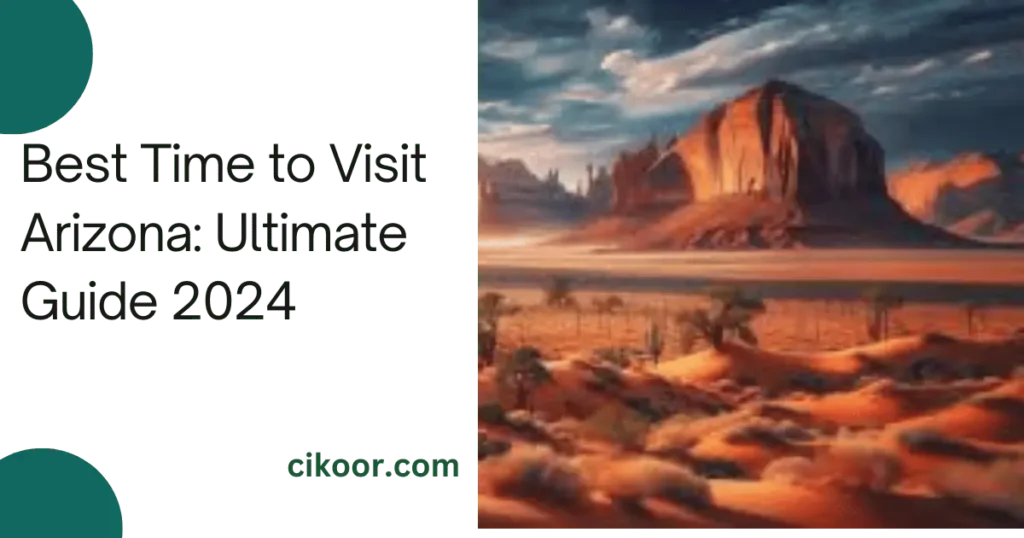Did you know that the Grand Canyon state of Arizona boasts over 300 days of sunshine each year? This makes it a prime spot for travelers. I’ve discovered that the best time to visit Arizona depends on what you want to experience, whether it’s the Grand Canyon, vacation, day, or sun seekers. If I’m chasing warm weather, late spring and early fall are perfect for outdoor adventures. For those who love cooler temps, winter offers unique activities like snow in the mountains. Each season brings its charm, making it essential to pick the right time for my trip. Knowing this helps me plan an unforgettable Arizona getaway.
Key Takeaways
- The best time to visit Arizona is during the spring (March to May) and fall (September to November) when temperatures are pleasant, making outdoor activities enjoyable.
- Understanding Arizona’s weather can help you plan your trip better. For example, summer can be extremely hot, especially in desert areas, so avoid outdoor activities during the hottest parts of the day.
- Different regions in Arizona have unique climates. For instance, northern Arizona is cooler and can even have snow in winter, while southern areas are much warmer. Choose your destination based on the type of weather you prefer.
- Use the month-by-month guide to plan your visit according to seasonal events and activities. For example, if you want to see wildflowers, spring is ideal, while fall offers beautiful foliage.
- Always check local events and festivals happening during your visit. This can enhance your experience by allowing you to participate in cultural activities or celebrations.
- Pack accordingly based on the time of year you visit. Bring layers for cooler evenings in spring and fall, and don’t forget sunscreen for sunny days.

Best Time to Visit Arizona
Spring & Fall
Spring and fall are the cooler months in Arizona. These seasons bring pleasant temperatures. I find it enjoyable to explore the breathtaking Grand Canyon during this time. The flowers bloom in spring, adding color to the landscape. In fall, the leaves change, creating a beautiful scene. Both seasons offer a great time for hiking and sightseeing.
Winter Adventures
Winter is also a fantastic time for visiting southern cities like Phoenix. The temperatures are mild, making outdoor activities comfortable. I love taking desert hikes during winter. The views of the saguaro cacti against the clear sky are stunning. Many people, known as snowbirds, travel to Arizona to escape colder climates. They enjoy the warm sun and vibrant scenery.
Summer Peak Season
Summer marks the peak season for national parks, including the mighty Grand Canyon. Despite high temperatures in desert areas, many visitors flock here. The South Rim remains accessible and offers breathtaking views. Early mornings or late afternoons are the best time to visit Arizona for exploring to avoid the heat. I recommend staying hydrated and wearing sunscreen if you go during summer.
Understanding Arizona’s Weather
Regional Variations
Arizona has a high desert environment. This means the weather can change a lot from one area to another. Southern Arizonans experience hot weather and little rain. In contrast, northern areas can see snow and storms during winter. I found it fascinating how you can enjoy sunbathing in Tucson while someone else is skiing in Flagstaff.
Seasonal Patterns
Visitors should consider seasonal weather patterns when planning their trip. Summer brings extreme heat, with average temperatures soaring above 100°F. Many people prefer spring or fall for milder conditions. These periods offer pleasant weather and blooming landscapes. Rainfall is more common in late summer, but it often comes as brief storms.
Sunshine Appeal
best time to visit Arizona boasts around 300 sunny days each year. This attracts many sun-seekers looking for warmth. The vast desert landscapes are stunning under clear blue skies. I remember my visit during the spring; the flowers were vibrant, and the temperatures were just right for hiking.
Weather Risks
best time to visit Arizona areas face risks like tornadoes and heavy rain during certain times of the year. Knowledge of these factors helps visitors stay safe and enjoy their time. Researching local forecasts before your visit is wise.

Exploring Regional Climates
Northern Regions
Northern Arizona offers a cooler climate. The temperatures here drop significantly in winter. This area sees unique snowfall, especially in places like Flagstaff. Snow creates fun opportunities for winter sports like skiing and snowboarding. I love visiting during this time. The snowy landscapes are breathtaking.
Southern Areas
there Arizona features warmer weather year-round. The desert regions can get extremely hot during summer. Temperatures often soar above 100°F. This intense heat limits outdoor activities, especially hiking. I prefer to plan my trips for the spring or fall when the weather is more pleasant.
Outdoor Activities
Arizona’s diverse climates shape its outdoor activities. In the north, winter sports thrive on snow-covered mountains. In contrast, southern areas boast sunny desert landscapes perfect for hiking in milder months. Dust storms can occur in these desert landscapes, especially in summer. It’s important to check the weather before heading out.
Festivals and Events
Various festivals celebrate Arizona’s unique climates throughout the year. Many take place in winter, showcasing winter sports and local culture in northern areas. In southern regions, spring brings vibrant events that highlight the beauty of the desert landscape. These events attract many visitors eager to experience the local culture.
Month-by-Month Guide
January
January is cool in Arizona. Average temperatures can range from 30 to 60 degrees Fahrenheit. This month is great for hiking and visiting national parks. I enjoy the quiet trails at this time.
February
February brings mild weather. It’s perfect for outdoor activities. Events like the Tucson Rodeo happen this month, attracting many visitors.
March
March marks the beginning of spring. Flowers bloom and temperatures rise. The average highs reach about 70 degrees. This is a popular time for tourists.
April
April offers warm days and cool nights. Many festivals take place, including the Phoenix Film Festival. This month is ideal for exploring local culture.
May
May heats up, with temperatures often above 80 degrees. Visitors flock to the Grand Canyon as it becomes more accessible. Early May is also a good time for wildflowers.
June
June signals the start of summer. Temperatures soar, often exceeding 100 degrees. It’s wise to plan water activities or indoor events to stay cool.
July
July is part of the monsoon season. Expect rain and thunderstorms, especially in the afternoons. The cooler evenings are refreshing after hot days.
August
August continues with monsoon weather. It’s humid but offers stunning sunsets. Outdoor events may be less crowded due to rain.
September
September marks the end of summer heat. Average temperatures drop back into the 80s. This month is great for hiking as conditions improve.
October
October brings beautiful fall colors and pleasant temperatures. Events like Halloween celebrations attract families and visitors alike.
November
November sees cooler weather again, perfect for outdoor adventures. The holiday season begins, bringing festive events throughout Arizona.
December
December offers a mix of activities and holiday cheer. Many towns have light displays and winter festivals, making it a magical time to visit.

closure of thoughts
I’ve shared the best times to visit Arizona based on its unique weather and regional climates. Each month offers something special, whether it’s hiking in cooler weather or enjoying vibrant festivals. Knowing these details helps me plan my trips effectively, ensuring I make the most out of my adventures.
If you’re looking to experience Arizona’s beauty, timing is everything. I recommend checking out the month-by-month guide to find the perfect fit for your plans. Don’t miss out on the stunning landscapes and rich culture waiting for you. Start planning your trip today and make unforgettable memories in Arizona!
Frequently Asked Questions
What is the best time to visit Arizona?
The best time to visit Arizona is during the spring (March to May) and fall (September to November). These seasons offer mild temperatures and fewer crowds, making outdoor activities more enjoyable.
How hot does it get in Arizona during summer?
Summer temperatures in Arizona can exceed 100°F (38°C), especially in desert regions like Phoenix. It’s essential to stay hydrated and avoid outdoor activities during peak heat hours for safety.
Is it a good idea to visit Arizona in winter?
Yes, visiting Arizona in winter (December to February) can be delightful. While northern areas may experience snow, southern regions remain mild, perfect for hiking and sightseeing without the summer heat.
What should I pack for a trip to Arizona?
Pack lightweight clothing for daytime, layers for cooler evenings, and sturdy shoes for hiking. Don’t forget sunscreen and a hat to protect against the sun’s intensity, regardless of the season.
Are there any seasonal events in Arizona worth attending?
Absolutely! Events like the Tucson Gem & Mineral Show in February and the Scottsdale Culinary Festival in April showcase local culture. These events enhance your travel experience and connect you with Arizona’s vibrant community.
How do regional climates affect my travel plans in Arizona?
Arizona has diverse climates. The north features cooler temperatures and snow, while the south is warm year-round. Understanding these differences helps you plan activities based on your preferred weather conditions.
Can I enjoy outdoor activities year-round in Arizona?
Yes, but timing is key. Spring and fall are ideal for most outdoor activities due to moderate temperatures. In summer, explore higher elevations like Flagstaff; winter offers unique experiences like skiing in northern Arizona.